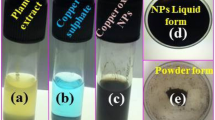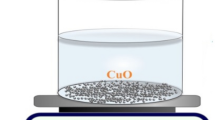Abstract
Copper hydrotalcites with and without adsorbed chlorophyllin exhibit a bactericidal effect that depends on the copper release and the basicity, which can be tuned through the chlorophyllin adsorption. The prepared solids performed well for the elimination of Escherichia coli, Enterobacter aerogenes, Salmonella enterica, and Staphylococcus aureus bacteria. The results showed that the copper-containing hydrotalcite with the adsorbed chlorophyllin is the most active material. Wastewaters from a metal industry were treated with these hybrid compounds, and the bactericidal effect was comparable with the results reported using more complex methods such as photocatalysis. Furthermore, one main advantage of these hybrid compounds is its low human toxicity compared with silver-containing materials.









Similar content being viewed by others
References
Aguzzi, C., Cerezo, P., Viseras, C., & Caramella, C. (2007). Use of clays as drug delivery systems: possibilities and limitations. Applied Clay Science, 36(1-3), 22–36.
Albright, L. J., & Wilson, E. M. (1974). Sub-lethal effects of several metallic salt-organic compound combinations upon heterotropic microflora of a natural water. Water Research, 8(2), 101–105.
Alena, A., & Sahu, O. (2013). Treatment of municipal wastewater by photocatalytic method. International Journal of Environmental Bioremediation & Biodegradation, 1(2), 49–53. doi:10.12691/ijebb-1-2-3.
Ayala, A., Fetter, G., Palomares, E., & Bosch, P. (2011). CuNi/Al hydrotalcites synthesized in presence of microwave irradiation. Materials Letters, 65(11), 1663–1665.
Blanch-Raga, N., Palomares, A. E., Martinez-Triguero, J., Fetter, G., & Bosch, P. (2013). Cu mixed oxides based on hydrotalcite-like compounds for the oxidation of trichloroethylene. Industrial and Engineering Chemistry Research, 52(45), 15772–15779.
Carli, L. N., Crespo, J. S., & Mauler, R. S. (2011). PHBV nanocomposites based on organomodified montmorillonite and halloysite: the effect of clay type on the morphology and thermal and mechanical properties. Composites: Part A, 42, 1601–1608.
De la Rosa-Gómez, I., Olguín, M. T., & Alcántara, D. (2008). Bactericides of coliform microorganisms from wastewater using silver-clinoptilolite rich tuffs. Applied Clay Science, 40(1-4), 45–53.
Demirci, S., Ustaoglu, Z., Yilmazer, G. A., Sahim, F., & Bac, N. (2014). Antimicrobial properties of zeolite-X and zeolite-A ion-exchanged with silver, copper, and zinc against a broad range of microorganisms. Applied Biochemistry and Biotechnology, 172(3), 1652–1662.
Díaz-Vissurraga, J., Daza, C., Pozo, C., Becerra, A., von Plessing, C., & García, A. (2012). Study on antibacterial alginate-stabilized copper nanoparticles by FT-IR and 2D-IR correlation spectroscopy. International Journal of Nanomedicine, 7, 3597–3612.
Evans, D. G., & Slade, R. C. T. (2006). Structural aspects of layered double hydroxides. In X. Duan & D. G. Evans (Eds.), Layered Double Hydroxides (pp. 1-87). Structure and Bonding series, 119. Berlin: Springer.
Gangadharan, D., Harshvardan, K., Gnanasekar, G., Dixit, D., Popat, K. M., & Anand, P. S. (2010). Polymeric microspheres containing silver nanoparticles as a bactericidal agent for water disinfection. Water Research, 44(18), 5481–5487.
He, J., Wei, M., Li, B., Kang, Y., Evans, D. G., & Duan, X. (2006). Preparation of layered double hydroxides. In X. Duan & D. G. Evans (Eds.), Layered Double Hydroxides (pp. 89-119). Structure and Bonding series, 119. Berlin: Springer.
Kawahara, K., Tsuruda, K., Morishita, M., & Uchida, M. (2000). Antibacterial effect of silver-zeolite on oral bacteria under anaerobic conditions. Dental Materials, 16, 452–455.
Kim, J. M., Sakamoto, Y., Hwang, Y. K., Kwon, Y. U., Terasaki, O., Park, S. E., & Stucky, G. D. (2002). Structural design of mesoporous silica by micelle-packing control using blends of amphiphilic block copolymers. The Journal of Physical Chemistry B, 106(10), 2552–2558.
Kim, T. N., Feng, Q. L., Kim, J. O., Wu, J., Wang, H., Chen, G. C., & Cui, F. Z. (1998). Antimicrobial effects of metal ions (Ag+, Cu2+, Zn2+) in hydroxyapatite. Journal of Materials Science: Materials in Medicine, 9(3), 129–134.
Köckerling, M., Geismar, G., Henkel, G., & Nolting, H.-F. (1997). X-ray absorption spectroscopic studies on copper-containing hydrotalcite. Journal of the Chemical Society, Faraday Transactions, 93, 481–484.
Peterson, C. L., Perry, D. L., Masood, H., Lin, H., White, J. L., Hem, S. L., Fritsch, C., & Haeusler, F. (1993). Characterization of antacid compounds containing both aluminum and magnesium. I. Crystalline powders. Pharmaceutical Research, 10(7), 998–1004.
Poyatos, J. M., Muñio, M. M., Almecija, M. C., Torres, J. C., Hontoria, E., & Osorio, F. (2010). Advanced oxidation processes for wastewater treatment: state of the art. Water, Air, & Soil Pollution, 205, 187–204.
Qu, X., Alvarez, P. J. J., & Li, Q. (2013). Applications of nanotechnology in water and wastewater treatment. Water Research, 47(12), 3931–3946.
Rai, M., Yadav, A., & Gade, A. (2009). Silver nanoparticles as a new generation of antimicrobials. Biotechnology Advances, 27(1), 76–83.
Rivera, J. A., Fetter, G., Giménez, Y., Xochipa, M. M., & Bosch, P. (2007). Nickel distribution in (Ni, Mg)/Al-layered double hydroxides. Applied Catalysis A, 316(2), 207–211.
Santo, C. E., Taudte, N., Nies, D. H., & Grass, G. (2008). Contribution of copper ion resistance to survival of Escherichia coli on metallic copper surfaces. Applied and Environmental Microbiology, 74(4), 977–986.
Sommer-Márquez, A. E., Lerner, D. A., Fetter, G., Bosch, P., Tichit, D., & Palomares, E. (2014). Preparation of layered double hydroxide/chlorophyll a hybrid nano-antennae: a key step. Dalton Transactions, 43, 10521–10528.
Sommer, A., Romero, A., Fetter, G., Palomares, A., & Bosch, P. (2013). Exploring and tuning the anchorage of chlorophyllin molecules on anionic clays. Catalysis Today, 212, 186–193.
Song, M. Y., Jung, H. D., Jurng, J., & Kim, B. C. (2014). Bacterial target-specific photocatalyst for the enhancement of antibacterial property to targets. Applied Catalysis B: Environmental, 148, 568–572.
Sunayama, S., Sato, T., Kawamoto, A., Ohkubo, A., & Suzuki, T. (2002). Disinfection effect of hydrotalcite compounds containing antimicrobial metals against microorganisms in water. Biocontrol Science, 7(2), 75–81.
Tumolo, T., & Lanfer-Marquez, U. M. (2012). Copper chlorophyllin: a food colorant with bioactive properties? Food Research International, 46, 451–459.
Zhang, D., Li, G., & Yu, J. C. (2010). Inorganic materials for photocatalytic water disinfection. Journal of Materials Chemistry, 20(22), 4529–4536.
Acknowledgments
Geolar Fetter at the Universidade de Caxias do Sul was a kind host during the sabbatical period and is gratefully acknowledged. CNPq, FAPERGS (Brazil), and CONACYT (Mexico) are also acknowledged for the financial support. The XRD and SEM technical expertise of Efraín Rubio (CUV-IT, BUAP) is also appreciated.
Author information
Authors and Affiliations
Corresponding author
Additional information
The main highlights of this work are
• Microwave irradiation is an alternative method to obtain chlorophyllin/copper hydrotalcites.
• Copper-containing hydrotalcites has a bactericide effect.
• Copper disposal and hydrotalcite basicity determined the bactericidal activity.
• Chlorophyllin/copper hydrotalcite was most effective to treat wastewater.
Rights and permissions
About this article
Cite this article
Rocha Oliveira, G., Dias do Amaral, L.J., Giovanela, M. et al. Bactericidal Performance of Chlorophyllin-Copper Hydrotalcite Compounds. Water Air Soil Pollut 226, 316 (2015). https://doi.org/10.1007/s11270-015-2585-1
Received:
Accepted:
Published:
DOI: https://doi.org/10.1007/s11270-015-2585-1




